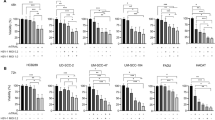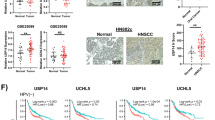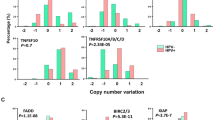Abstract
Far-upstream element-binding protein-interacting repressor (FIR) is a transcription factor that inhibits c-Myc expression and has been shown to have antitumor effects in some malignancies. Here, we evaluated the antitumor effects of FIR using fusion gene-deleted Sendai virus (SeV/ΔF) as a nontransmissible vector against head and neck squamous cell carcinoma (HNSCC). Using in vitro and in vivo xenograft mouse models, we observed efficient expression of green fluorescent protein (GFP) following transduction with the SeV/ΔF vector encoding GFP (GFP-SeV/ΔF) into HNSCC cells. In vitro and in vivo studies revealed that administration of the FIR-encoded SeV/ΔF (FIR-SeV/ΔF) vector exerted significant antitumor effects, suppressed c-Myc expression and induced apoptosis in HNSCC. Additionally, the antitumor effects of FIR or the expression of GFP following administration of the FIR- or GFP-SeV/ΔF vector, respectively, were dependent on the multiplicity of infection or titer. Furthermore, the SeV/ΔF vector itself had no cytotoxic effects. Therefore, the SeV/ΔF vector may be safe and useful for the treatment of HNSCC, allowing for high-titer SeV/ΔF vector administration for anticancer gene therapy. In addition, SeV/ΔF vector-mediated FIR gene therapy demonstrated effective tumor suppression in HNSCC, suggesting that this therapy may have the potential for clinical use as a novel strategy for HNSCC treatment.
This is a preview of subscription content, access via your institution
Access options
Subscribe to this journal
Receive 12 print issues and online access
$259.00 per year
only $21.58 per issue
Buy this article
- Purchase on Springer Link
- Instant access to full article PDF
Prices may be subject to local taxes which are calculated during checkout






Similar content being viewed by others
References
Matta A, Ralhan R . Overview of current and future biologically based targeted therapies in head and neck squamous cell carcinoma. Head Neck Oncol 2009; 1: 6.
Chaikhoutdinov I, Goldenberg D . Impact of genetic targets on therapy in head and neck squamous cell carcinoma. Adv Exp Med Biol 2013; 779: 165–177.
Li D, Guang W, Abuzeid WM, Roy S, Gao GP, Sauk JJ et al. Novel adenoviral gene delivery system targeted against head and neck cancer. Laryngoscope 2008; 118: 650–658.
Thomas SM, Grandis JR . The current state of head and neck cancer gene therapy. Hum Gene Ther 2009; 20: 1565–1575.
Hsiao HH, Nath A, Lin CY, Folta-Stogniew EJ, Rhoades E, Braddock DT . Quantitative characterization of the interactions among c-myc transcriptional regulators FUSE, FBP, and FIR. Biochemistry 2010; 49: 4620–4634.
Riva C, Lavieille JP, Reyt E, Brambilla E, Lunardi J, Brambilla C . Differential c-myc, c-jun, c-raf and p53 expression in squamous cell carcinoma of the head and neck: implication in drug and radioresistance. Eur J Cancer B 1995; 31B: 384–391.
Pérez-Sayáns M, Suárez-Peñaranda JM, Pilar GD, Barros-Angueira F, Gándara-Rey JM, García-García A . What real influence does the proto-oncogene c-myc have in OSCC behavior? Oral Oncol 2011; 47: 688–692.
Schraml P, Kononen J, Bubendorf L, Moch H, Bissig H, Nocito A et al. Tissue microarrays for gene amplification surveys in many different tumor types. Clin Cancer Res 1999; 5: 1966–1975.
Cascón A, Robledo M . MAX and MYC: a heritable breakup. Cancer Res 2012; 72: 3119–3124.
Chung HJ, Levens D . c-myc expression: keep the noise down!. Mol Cells 2005; 20: 157–166.
Soucek L, Whitfield J, Martins CP, Finch AJ, Murphy DJ, Sodir NM et al. Modelling Myc inhibition as a cancer therapy. Nature 2008; 455: 679–683.
Avigan MI, Strober B, Levens D . A far upstream element stimulates c-myc expression in undifferentiated leukemia cells. J Biol Chem 1990; 265: 18538–18545.
Liu J, He L, Collins I, Ge H, Libutti D, Li J et al. The FBP interacting repressor targets TFIIH to inhibit activated transcription. Mol Cell 2000; 5: 331–341.
Matsushita K, Tomonaga T, Shimada H, Shioya A, Higashi M, Matsubara H et al. An essential role of alternative splicing of c-myc suppressor FUSE-binding protein-interacting repressor in carcinogenesis. Cancer Res 2006; 66: 1409–1417.
Li HO, Zhu YF, Asakawa M, Kuma H, Hirata T, Ueda Y et al. A cytoplasmic RNA vector derived from nontransmissible Sendai virus with efficient gene transfer and expression. J Virol 2000; 74: 6564–6569.
Kitamura A, Matsushita K, Takiguchi Y, Shimada H, Tada Y, Yamanaka M et al. Synergistic effect of non-transmissible Sendai virus vector encoding the c-myc suppressor FUSE-binding protein-interacting repressor plus cisplatin in the treatment of malignant pleural mesothelioma. Cancer Sci 2011; 102: 1366–1373.
Ginn SL, Alexander IE, Edelstein ML, Abedi MR, Wixon J . Gene therapy clinical trials worldwide to 2012 - an update. J Gene Med 2013; 15: 65–77.
Raper SE, Chirmule N, Lee FS, Wivel NA, Bagg A, Gao GP et al. Fatal systemic inflammatory response syndrome in a ornithine transcarbamylase deficient patient following adenoviral gene transfer. Mol Genet Metab 2003; 80: 148–158.
Hacein-Bey-Abina S, Garrigue A, Wang GP, Soulier J, Lim A, Morillon E et al. Insertional oncogenesis in 4 patients after retrovirus-mediated gene therapy of SCID-X1. J Clin Invest 2008; 118: 3132–3142.
Howe SJ, Mansour MR, Schwarzwaelder K, Bartholomae C, Hubank M, Kempski H et al. Insertional mutagenesis combined with acquired somatic mutations causes leukemogenesis following gene therapy of SCID-X1 patients. J Clin Invest 2008; 118: 3143–3150.
Yonemitsu Y, Kitson C, Ferrari S, Farley R, Griesenbach U, Judd D et al. Efficient gene transfer to airway epithelium using recombinant Sendai virus. Nat Biotechnol 2000; 18: 970–973.
Mizokami D, Araki K, Tanaka N, Suzuki H, Tomifuji M, Yamashita T et al. Sendai virus transgene in a novel gene therapy for laryngotracheal disease. Laryngoscope 2013; 123: 1717–1724.
Kanzaki S, Shiotani A, Inoue M, Hasegawa M, Ogawa K . Sendai virus vector-mediated transgene expression in the cochlea in vivo. Audiol Neurootol 2007; 12: 119–126.
Shiotani A, Fukumura M, Maeda M, Hou X, Inoue M, Kanamori T et al. Skeletal muscle regeneration after insulin-like growth factor I gene transfer by recombinant Sendai virus vector. Gene Ther 2001; 8: 1043–1050.
Shirakura M, Inoue M, Fujikawa S, Washizawa K, Komaba S, Maeda M et al. Postischemic administration of Sendai virus vector carrying neurotrophic factor genes prevents delayed neuronal death in gerbils. Gene Therapy 2004; 11: 784–790.
Ban H, Inoue M, Griesenbach U, Munkonge F, Chan M, Iida A et al. Expression and maturation of Sendai virus vector-derived CFTR protein: functional and biochemical evidence using a GFP-CFTR fusion protein. Gene Therapy 2007; 14: 1688–1694.
Hara H, Hara H, Hironaka T, Inoue M, Iida A, Shu T et al. Prevalence of specific neutralizing antibodies against Sendai virus in populations from different geographic areas: implications for AIDS vaccine development using Sendai virus vectors. Hum Vaccin 2011; 7: 639–645.
Takahashi K, Yamanaka S . Induction of pluripotent stem cells from mouse embryonic and adult fibroblast cultures by defined factors. Cell 2006; 126: 663–676.
Yonemitsu Y, Matsumoto T, Itoh H, Okazaki J, Uchiyama M, Yoshida K et al. DVC1-0101 to treat peripheral arterial disease: a Phase I/IIa open-label dose-escalation clinical trial. Mol Ther 2013; 21: 707–714.
Matsushita K, Kajiwara T, Tamura M, Satoh M, Tanaka N, Tomonaga T et al. SAP155-mediated splicing of FUSE-binding protein-interacting repressor serves as a molecular switch for c-myc gene expression. Mol Cancer Res 2012; 10: 787–799.
Matsushita K, Tamura M, Tanaka N, Tomonaga T, Matsubara H, Shimada H et al. Interactions between SAP155 and FUSE-binding protein-interacting repressor bridges c-Myc and P27Kip1 expression. Mol Cancer Res 2013; 11: 689–698.
Rahmutulla B, Matsushita K, Satoh M, Seimiya M, Tsuchida S, Kubo S et al. Alternative splicing of FBP-interacting repressor coordinates c-Myc, P27Kip1/cyclinE and Ku86/XRCC5 expression as a molecular sensor for bleomycin-induced DNA damage pathway. Oncotarget 2014; 5: 2404–2417.
Jäkel H, Peschel I, Kunze C, Weinl C, Hengst L . Regulation of p27 (Kip1) by mitogen-induced tyrosine phosphorylation. Cell Cycle 2012; 11: 1910–1917.
Chu IM, Hengst L, Slingerland JM . The Cdk inhibitor p27 in human cancer: prognostic potential and relevance to anticancer therapy. Nat Rev Cancer 2008; 8: 253–267.
Roussel MF . Key effectors of signal transduction and G1 progression. Adv Cancer Res 1998; 74: 1–24.
Matsushita K, Shimada H, Ueda Y, Inoue M, Hasegawa M, Tomonaga T et al. Non-transmissible Sendai virus vector encoding c-myc suppressor FBP-interacting repressor for cancer therapy. World J Gastroenterol 2014; 20: 4316–4328.
Matsui T, Ota T, Ueda Y, Tanino M, Odashima S . Isolation of a highly metastatic cell line to lymph node in human oral squamous cell carcinoma by orthotopic implantation in nude mice. Oral Oncol 1998; 34: 253–256.
Inoue M, Tokusumi Y, Ban H, Kanaya T, Tokusumi T, Nagai Y et al. Nontransmissible virus-like particle formation by F-deficient sendai virus is temperature sensitive and reduced by mutations in M and HN proteins. J Virol 2003; 77: 3238–3246.
Tanaka N, Yamashita T, Yamamoto S, Matsunobu T, Tsuda H, Honda K et al. Histological growth pattern of and alpha-actinin-4 expression in thyroid cancer. Anticancer Res 2014; 34: 3157–3163.
Acknowledgements
We thank Dr T Ota for providing the HSC-3-M3 cell line. A part of this paper was presented in July 2012 at the 8th International Conference on Head and Neck Cancer in Toronto, Canada. This work was supported by a Special Research Grant on Defense Medicine from the Ministry of Defense of Japan, Grant-in-Aid for Scientific Research (C) (JSPS KAKENHI Nos. 23592544, 23592545, 25462699 and 26462627) and Grant-in-Aid for Challenging Exploratory Research (JSPS KAKENHI No. 25670723).
Author information
Authors and Affiliations
Corresponding author
Ethics declarations
Competing interests
The authors declare no conflict of interest.
Rights and permissions
About this article
Cite this article
Tanaka, N., Araki, K., Mizokami, D. et al. Sendai virus-mediated gene transfer of the c-myc suppressor far-upstream element-binding protein-interacting repressor suppresses head and neck cancer. Gene Ther 22, 297–304 (2015). https://doi.org/10.1038/gt.2014.123
Received:
Revised:
Accepted:
Published:
Issue Date:
DOI: https://doi.org/10.1038/gt.2014.123



